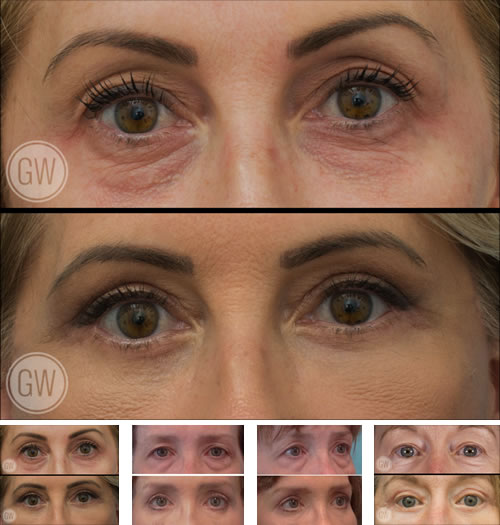
Eyelid Rejuvenation – Blepharoplasty
The eyes are one of the first features people notice about us and play a significant role in expressing our emotions and feelings. However, with age, stress, and other environmental factors, our eyelids can begin to droop, develop wrinkles, or exhibit puffiness, making us look tired, older, or even affecting our vision. Eyelid rejuvenation, also known as blepharoplasty, offers a solution to these concerns, giving individuals a refreshed appearance.
What Is Blepharoplasty?
Blepharoplasty is a surgical procedure designed to improve the appearance of the eyelids. It can be performed on the upper lids, lower lids, or both. The primary goal of this surgery is to remove excess skin, muscle, and sometimes fat that may be causing droopiness or bags under the eyes. Whether you’re looking to enhance your appearance or improve functional problems with your eyelids, blepharoplasty can rejuvenate the area surrounding your eyes, making you look more rested and alert.
Who Is a Good Candidate for Blepharoplasty?
Blepharoplasty is a plastic surgery procedure that can rejuvenate the appearance of the eyes and restore a refreshed look. However, not everyone is an ideal candidate for this surgery. Determining suitability involves a combination of physical factors, health conditions, and personal motivations. Here’s a breakdown of what makes someone a good candidate for blepharoplasty:
Physical Indications:
- Sagging Skin: One of the primary reasons individuals seek blepharoplasty is due to excess skin on the upper eyelids that droops, sometimes even obstructing vision
- Under-Eye Bags: Puffiness or bags under the eyes, often a result of fat accumulation, can make a person appear tired or aged
- Wrinkles: Fine lines and wrinkles around the eyes, especially on the lower eyelids, can be addressed with this procedure
Overall Health: A good candidate should be in general good health. This means:
- No Serious Eye Conditions: Conditions like glaucoma, dry eye, or a detached retina can complicate the procedure. It’s essential to have a thorough eye examination before considering surgery
- Non-Smokers: Smoking can interfere with the healing process, so non-smokers or those willing to quit before and after the surgery are better candidates
- No Serious Medical Conditions: Chronic illnesses or conditions that can affect healing might rule out surgery or require additional precautions
Realistic Expectations: It’s crucial for candidates to have realistic expectations about the outcomes of the surgery. While blepharoplasty can significantly enhance one’s appearance and, in some cases, improve vision, it won’t fundamentally change your facial structure or make you look like a completely different person. A thorough discussion with Dr. Watts can help set achievable goals.
Motivation: The decision to undergo blepharoplasty should be a personal one, made without external pressures. Whether the motivation is cosmetic enhancement, functional improvement, or a combination of both, the candidate should feel confident in their choice.
Age Considerations: While there’s no specific age limit for blepharoplasty, most candidates are typically in their 30s or older when signs of ageing become more pronounced. However, in some cases, younger individuals might opt for the procedure due to hereditary factors that cause droopy eyelids or under-eye bags at a younger age.
REQUEST AN APPOINTMENT
WHAT CAN A BLEPHAROPLASTY DO FOR ME?
• Remove excess and loose skin from around the eyes
• Reduce puffiness
• Correct ‘bags’ on the lower lid
• Improve vision from removal of excess eyelid skin
• Improve ‘hooding’ on the upper lid
• Improve symmetry of the lids
• Correct a drooping lower lid that exposes the white of the lower eye
• Rejuvenate and refresh the appearance of the eyes and face
In addition to surgical enhancement, non-surgical techniques such as chemical peels, dermal fillers and wrinkle relaxers can aid in improving the textural or surface changes around the eyes. These can include improvement of fine lines, deep wrinkles, crow’s feet and thin papery skin. Dr Watts will discuss with you which procedure or combination of procedures will deliver you the optimal, long lasting results. His Perth-based practice is always happy to receive enquiries and field your questions.
BLEPHAROPLASTY PROCEDURE AND RECOVERY PERIOD
How Is the Surgery Performed?
Blepharoplasty is a delicate procedure that requires precision, expertise, and a deep understanding of facial anatomy. The specific techniques and approaches can vary based on the patient’s needs, Dr Watts’ preferences, and whether the surgery is being performed on the upper eyelids, lower eyelids, or both.
- Pre-Surgical Preparation: Before the surgery, Dr. Watts will conduct a thorough examination of the patient’s eyes and the surrounding area. This includes assessing the amount of excess skin, the distribution of fat, and the general health of the eyes. The patient might also undergo vision tests and tear production tests. Photographs may be taken for before-and-after comparisons. It’s essential for patients to disclose their full medical history, including any medications or supplements they are taking, as some can interfere with the surgery or recovery.
- Anaesthesia: Blepharoplasty can be performed under local anaesthesia, sedation, or general anaesthesia, depending on the extent of the surgery and the surgeon’s preference. Local anaesthesia numbs the eyelid area, ensuring the patient feels no pain during the procedure. If sedation or general anaesthesia is used, the patient will be asleep or in a deep state of relaxation.
- Incisions: For upper eyelid surgery, the incision is made along the natural crease of the eyelid. This ensures that the resultant scar is well-hidden. For the lower eyelid, the incision can be made just below the lash line or inside the eyelid, known as a transconjunctival incision. The choice of incision depends on the specific goals of the surgery, such as removing excess skin or repositioning fat.
- Reshaping and Removal: Once the incision is made, Dr. Watts will remove or reposition excess fat deposits, tighten muscles, and remove sagging skin. In some cases, fat may be redistributed to eliminate puffiness or bulges.
- Closing the Incisions: After the necessary adjustments have been made, the incisions are closed with sutures, skin adhesives, or surgical tape. The sutures might be absorbable, or they might need removal after a few days.
Recovery after Surgery
The recovery process after blepharoplasty is as crucial as the surgery itself. Proper care and adherence to post-operative instructions can significantly influence the final outcome and the speed of recovery.
- Immediate Post-Operative Period: After the surgery, patients might experience some degree of swelling, bruising, irritation, or dryness in the eyes. Cold compresses can help reduce swelling, and ointment can alleviate dryness or irritation. It’s not uncommon for the eyes to feel tight or sore as the anaesthesia wears off, but pain medication can manage this discomfort
- First Week of Recovery: During the first week, patients should keep their heads elevated, even while sleeping, to minimise swelling. Activities should be limited, and strenuous exercises, bending, or lifting should be avoided. It’s also essential to protect the eyes from direct sunlight and wind by wearing sunglasses
- Follow-Up Appointments: Patients will have scheduled follow-up appointments to monitor the healing process. If non-absorbable sutures were used, they would be removed within a week. Dr. Watts will provide guidance on when it’s safe to resume regular activities and return to work
- Long-Term Recovery: While the majority of swelling and bruising will subside within a couple of weeks, it might take several months for the final results to become apparent. Scars from the incisions will fade over time and should become barely noticeable. It’s crucial for patients to maintain a healthy lifestyle, protect their eyes from the sun, and follow any specific instructions from Dr. Guy Watts to ensure the longevity of the results
Risks of Blepharoplasty Surgery
Plastic surgery comes with inherent risks. While modern techniques and advancements have made these procedures safer than ever, it’s crucial for patients to be aware of potential complications and make informed decisions. Anaesthesia is used in most surgical procedures to ensure the patient’s comfort. However, in rare cases, it can lead to complications such as allergic reactions, lung infections, stroke, and even heart complications.
Also, keep in mind that all surgeries result in some form of scarring. While Dr. Watts often uses techniques to minimise and strategically place these scars, some patients might experience hypertrophic or keloid scarring, which is raised and more prominent. It’s essential for anyone considering plastic surgery to thoroughly research and understand these risks. Read more about risks and potential complications of plastic surgery.
FAQs about Eyelid Surgery
Who is an ideal candidate for blepharoplasty?
- An ideal candidate for blepharoplasty is someone in good overall health, without any serious eye conditions. Individuals who have realistic expectations, non-smokers, and those who experience functional problems due to droopy eyelids or simply wish to improve their appearance can consider this procedure. A thorough consultation with Dr. Watts is essential to determine suitability.
Are there any potential risks or complications associated with the surgery?
- As with any surgical procedure, blepharoplasty comes with potential risks. These can include infection, bleeding, dry eyes, and difficulty closing the eyes, noticeable scarring, or even temporary or permanent changes in vision. It’s essential to discuss these risks with Dr. Watts and understand the steps taken to minimise them.
How long do the results of blepharoplasty last?
- The results of blepharoplasty are long-lasting. Over time, natural ageing might lead to some relaxation of tissues, but the benefits of the surgery should remain for many years. Many patients find that they don’t seek a repeat procedure for a decade or more.
Can blepharoplasty be combined with other facial procedures?
- Yes, many patients choose to combine blepharoplasty with other facial rejuvenation procedures, such as a facelift, brow lift, or skin resurfacing treatments. Combining procedures can provide a more comprehensive approach to facial rejuvenation and can also be cost-effective and convenient, as it reduces the overall recovery time compared to having separate surgeries.
Will insurance cover the cost of blepharoplasty?
- If the surgery is being performed for cosmetic reasons, insurance typically does not cover the costs. However, if the procedure is deemed medically necessary, such as when droopy eyelids obstruct vision, insurance might cover part or all of the expenses. It’s essential to check with your insurance provider and get any necessary pre-approvals.
How should I prepare for the surgery?
- Watts will provide specific pre-operative instructions. Generally, patients are advised to stop taking certain medications or supplements that can increase bleeding, avoid smoking, and ensure they have someone to drive them home post-surgery. It’s also a good idea to prepare your recovery area at home with essential items like cold compresses, prescribed medications, and comfortable pillows to keep the head elevated.
Medical References about Blepharoplasty
- Blepharoplasty | Cosmetic Surgery – Stanford Medicine
- Blepharoplasty – Mayo Clinic
- Blepharoplasty: An Overview – PMC
Next Steps on Your Plastic Surgery Journey
PLEASE TAKE INTO CONSIDERATION
Any surgical or invasive procedure carries risks. Before proceeding, you should seek a second opinion from an appropriately qualified health practitioner.
Dr. Guy Watts – Specialist Plastic Surgeon In Perth WA
Dr. Guy Watts (AHPRA Medical Reg. MED0001539378) is a Specialist Plastic Surgeon with an extensive career that spans across renowned plastic surgery clinics worldwide. His exceptional expertise has been honed through invaluable experiences at esteemed establishments such as the prestigious New York Eye and Ear Infirmary and the renowned Pitanguy Clinic in Brazil.
Having collaborated with the foremost cosmetic plastic surgeons on a global scale, Dr. Watts has chosen to return to Perth after a remarkable 17-year journey of intensive training and invaluable professional experience to bring the latest practices and technology in cosmetic plastic surgery to his patients.
Dr. Watts is a Fellow of the Royal College of Surgeons (FRACS) and a Member of the Australian Society of Plastic Surgeons (ASPS), Australasian Society of Aesthetic Plastic Surgeons (ASAPS) and the International Society of Aesthetic Plastic Surgeons (ISAPS).









